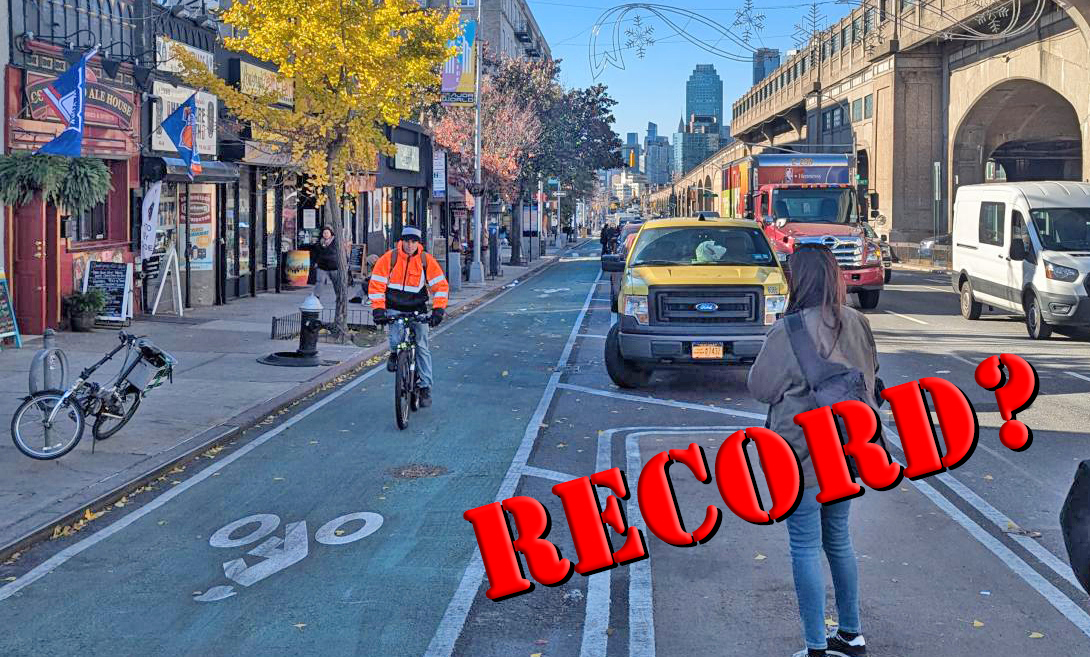The term “livable streets” first surfaced in 1981. That’s when UC Berkeley urban planning professor Donald Appleyard made it the title of his path-breaking new book on the social effects of cars on cities. But it was the advent of Streetsblog and the livable streets movement 25 years later that brought the term into public view.

The beauty of “livable streets” and of the movement bearing its name is that it unites under one rubric what had long been largely separate concerns -- better bicycling, safer walking, affordable transit, inviting public spaces, urban sustainability. The term also recasts a negative as a positive, turning what could appear invasive -- “getting people out of their cars” -- into something situational: creating streets for people.
Try telling that, though, to the folks at the Manhattan Institute, who this week published a spectacularly retrograde piece, Idle in Manhattan, by one Herbert London, retired academician and one-time NY State Conservative Party candidate for governor. Writing in the Institute’s City Journal, London trots out one canard after another: Londoners “grudgingly” tolerate congestion pricing ... “Most bicyclists in Manhattan are delivery carriers” ... “In one hour [at the First Ave. bike lane] I counted just two bicycles” ... “the mayor[‘s] efforts to control traffic … have only increased congestion.”
It takes about a minute of fact-checking or direct observation to rebut these claims. But what’s striking about (Herbert) London’s diatribe isn’t just its counterfactualism, but its willful ignorance of how livable streets change the way urban transportation systems function.
Pondering the genesis of the Bloomberg administration’s bike lanes and pedestrian plazas, London can’t conceive that the mayor was connecting the dots between physical activity, fighting obesity and downsizing health-care costs. Or had learned from his planning and transportation commissioners about cities in Europe where active transportation (biking and walking) accounted for as many as half of all trips, and workers, residents and tourists alike flocked to the city centers. Or thought it was worth putting a handful of districts on a road diet to see if the maxim that turning more street space over to cars produces more gridlock, could be run in reverse.
No, according to Herbert London, the mayor’s attempt to try out livable streets practices in New York is proof that “the Bloomberg administration has declared war on the automobile.”
Yet the facts show that city drivers aren’t victims of the emerging street paradigm, they’re beneficiaries — not just in Midtown, where car speeds have risen following introduction of the Broadway plazas, but throughout the Manhattan Central Business District.
Where the official report to the Traffic Congestion Mitigation Commission found that "GPS data for October 2007 show that taxi trips average ... 8 mph within the CBD as a whole (below 60th Street), between 8 am and 6 pm," taxi GPS data from October 2010 now put the average at 9.5 mph. In percentage terms (which is where, mathematically, travel time savings accumulate), this 1.5 mph gain is huge — enough to save commuters and truckers over 50,000 hours a day. Even applying very conservative “values of time,” that’s half-a-billion dollars a year New Yorkers are holding onto by not sitting in traffic.
What brought this change? The recession is partly responsible, for sure, but in previous downturns traffic congestion never eased to this extent. There are a host of other likely factors — the reinforcing effects of three decades of capital investment in mass transit, the rising use of unlimited farecards, a shift of the zeitgeist toward both active transportation and transit-friendly smartphones, and, yes, the provisions being made for walking and cycling, including the public plazas and bike lanes sneered at by Mr. London, which allow New Yorkers to get around more and drive less.
The irony is that not long ago, the Manhattan Institute was actively engaged in untangling threads like these. In 2006, it commissioned transportation savant Bruce Schaller to examine the gridlock-busting potential of congestion pricing, and it presented his findings at a major forum. The buzz from that meeting, along with a Times op-ed by Bruce (now a deputy commissioner at NYC DOT) and his then-colleague Hope Cohen (now at RPA), helped set the table for the mayor’s PlaNYC push the following spring. But that was before conservatism congealed into resistance and denial, and urban livability became anathema to the right wing.





